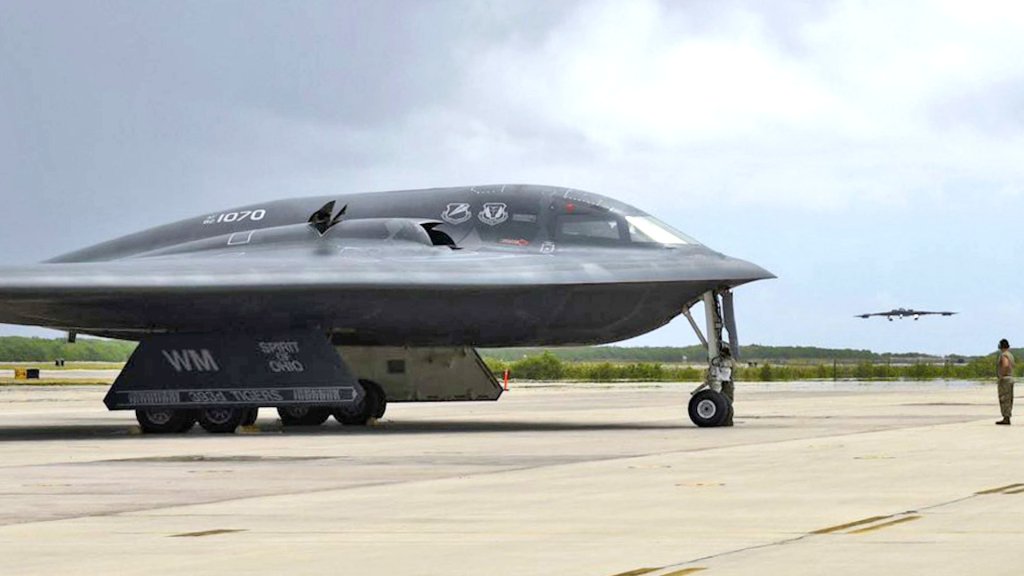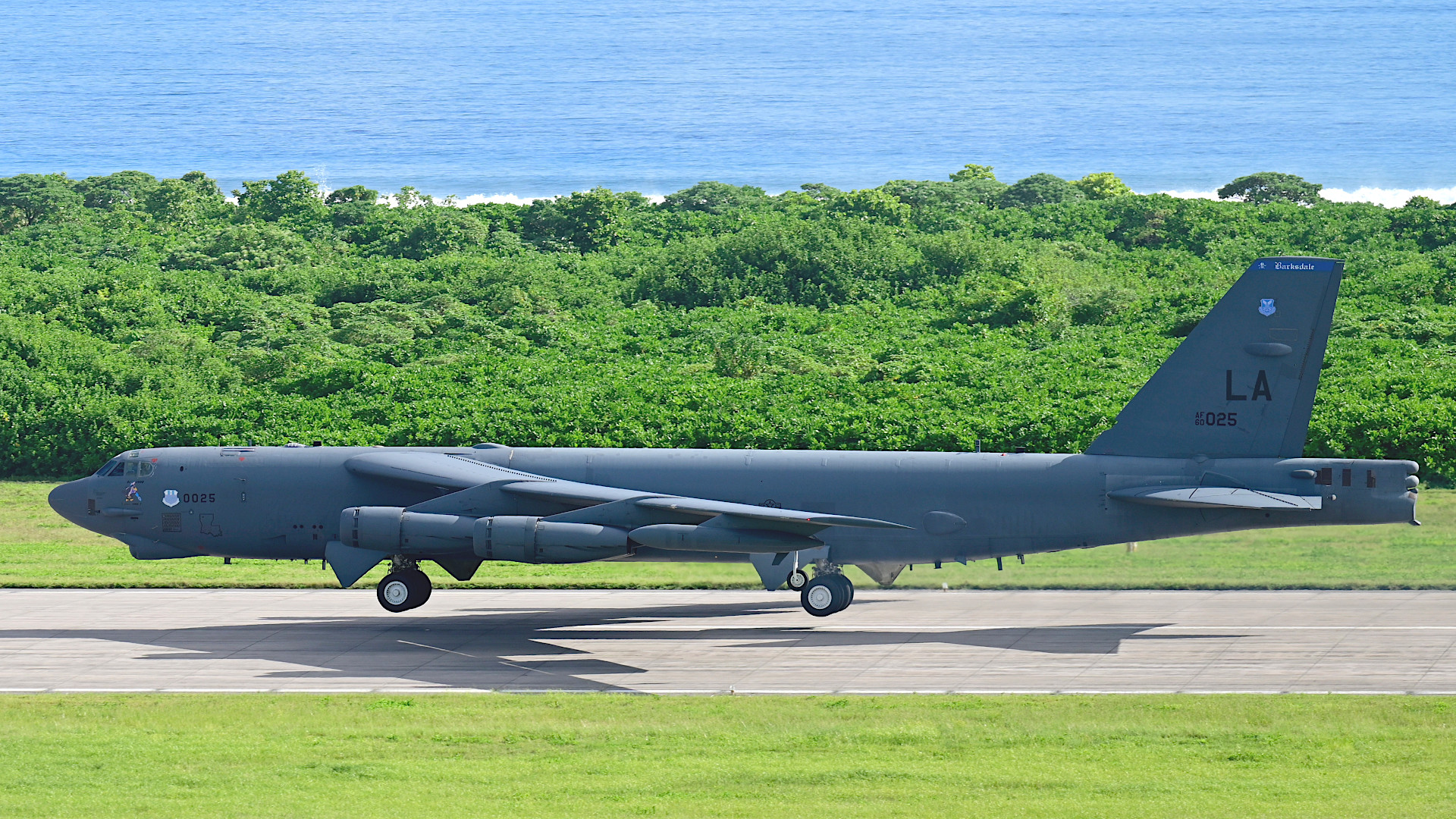Satellite imagery indicates there are now 10 U.S. heavy bombers – six stealthy B-2s and four B-52s – on Diego Garcia in the Indian Ocean. A key question now is whether the arrival of the B-52s, which occurred this week, will lead to the B-2s departing the highly strategic British island territory. Since they first deployed to Diego Garcia in March, the B-2s have been used in strikes against Houthi militants in Yemen, with which U.S. authorities recently concluded a ceasefire deal, and their presence has also been a huge show of force aimed at Iran.
A low-resolution satellite image taken today, seen in the social media post below, appears to show the six B-2s and four B-52s. An array of other large aircraft, which could include KC-135 tankers, as well as C-5 and C-17 airlifters, are also visible. KC-135s arrived at Diego Garcia along with the B-2 in March, and C-17s have also been key to supporting that deployment.
Satellite imagery had already emerged yesterday that looked to show a pair of B-52s having touched down on the Indian Ocean island. This all also aligns with online flight tracking data that began emerging earlier in the week, which had pointed to the deployment of two separate pairs of B-52s from Barksdale Air Force Base in Louisiana to Diego Garcia.
While testifying before members of the House Armed Services Committee yesterday, U.S. Air Force Lt. Gen. Andrew Gebara, Deputy Chief of Staff for Strategic Deterrence and Nuclear Integration, did say “there’s a Bomber Task Force of B-52s going on as we speak,” but did not name Diego Garcia or provide any additional details.
The Air Force uses the term Bomber Task Force (BTF) to refer to irregular deployments of bombers to forward locations around the world, as you can read more about here. The last known B-52 BTF deployment, which saw four of the bombers head to RAF Fairford in the United Kingdom from Minot Air Force Base in North Dakota, wrapped up in March.

In response to questions about the B-52 deployment and whether the B-2s will now depart Diego Garcia, a U.S. defense official told TWZ that “we have nothing to provide.”

Air Force Global Strike Command (AFGSC) “routinely conducts global operations in coordination with other combatant commands, services, and participating U.S. government agencies to deter, detect and, if necessary, defeat strategic attacks against the United States and its allies. To preserve operational security, we do not discuss details about exercises or operations,” the command, which oversees the vast majority of America’s B-52s and other bomber fleets, also told Air & Space Forces Magazine in a statement.
Sending six B-2s to Diego Garcia in March was already a major show of force. This represents roughly a third of the 19 of these stealth bombers currently in operational Air Force service. Only a portion of the B-2 fleet is actually available for mission taskings at any one time, too.

The B-2s are the Air Force’s preeminent aircraft for prosecuting penetrating nuclear or conventional direct strikes deep inside heavily defended enemy territory. The stealth bombers also offer a unique conventional strike capability against deeply buried and otherwise hardened targets through their ability to drop 30,000-pound-class GBU-57/B Massive Ordnance Penetrator (MOP) precision-guided bunker buster bombs. B-2s, each of which can carry a pair of MOPs on a single sortie, are the only aircraft currently certified to employ these weapons operationally.

In April, U.S. officials told TWZ that, despite reports at the time, B-2s flying from Diego Garcia had not dropped MOPs on Houthi targets in Yemen. Since March, B-2s forward-deployed to the Indian Ocean island have conducted strikes targeting the Iranian-backed Yemeni militants using other still unspecified munitions. B-2s flying from their main operating base in Missouri had also struck the Houthis last October with a still unknown mix of weapons.
Questions have emerged previously about the utility of employing B-2s, which are very expensive to operate and maintain, against a non-state group like the Houthis. At the same time, the Yemeni militants have demonstrated that they have air defense capabilities that present real threats. This, in turn, may have contributed to the use of stealthy aircraft like the B-2 and the F-35 Joint Strike Fighter, as well as a noted increase in the employment of air-launched stand-off munitions by non-stealthy U.S. aircraft. The Houthis have succeeded in downing an alarming number of U.S. MQ-9 Reaper drones. You can read more about what we know about Houthi air defenses in this recent TWZ feature.
As already noted, sending such a large number of B-2s to Diego Garcia had also sent signals well beyond Yemen, particularly to Iran. TWZ had highlighted the strategic messaging factor of employing the stealth bombers after the October 2024 strikes on the Houthis.
Diego Garcia was used for years as a launchpad for bomber sorties against targets in Afghanistan and Iraq. The U.S. military has also previously sent B-52s to the Indian Ocean island amid heightened tensions with Iran in the past, though they do not offer the penetrating and GBU-57/B employment capabilities of the B-2. B-52s have dropped MOPs during testing, but are not cleared to do so on operational missions. B-52s can employ a wide range of other munitions, including AGM-158 Joint Air-to-Surface Standoff Missile (JASSM) cruise missiles and smaller precision-guided bunker-buster bombs.

It’s interesting to note that Gebara also highlighted the value of having a mix of stealth bombers like the B-2s and the incoming replacement B-21 Raiders, and non-stealthy B-52s, at yesterday’s hearing before the House Armed Services Committee. The Air Force’s B-52 fleet is in the process of being massively upgraded and is expected to continue serving through at least 2050, as you can read more about here.
“The decision to go forward with the B-52 was a decision made several years ago in that we needed a high-low mix of capabilities,” he said. “So, it would not be cost-effective to the American taxpayer to have all high-end, exquisite things when many missions could be done with the proverbial ‘old truck’ that’s paid for and we just need to do some upgrades to it.”
The current massing of the huge force of U.S. heavy bombers on Diego Garcia now does follow the announcement of a ceasefire deal between the U.S. government and the Houthis on May 6, which officials in Oman helped broker. There is already skepticism about whether the agreement will hold, especially given that the Iranian-backed Yemeni militants have pledged to continue their campaign against Israel.
The Houthis say they will continue to target Israel until it stops its operations in the Gaza Strip, which first began in response to attacks launched by Palestinian terrorist groups in the enclave on Oct. 7, 2023. Israel, just this week, has conducted its own major airstrikes on Yemen’s port of Hodeidah and the international airport in the country’s capital Sanaa.

The U.S. government is also currently engaged in negotiations with Iran, primarily over the latter country’s nuclear ambitions. In recent months, President Donald Trump and other American officials have threatened direct action against Iran should those talks fall through, as well as over Tehran’s continued support of regional proxies like the Houthis.
“I would much prefer a strong, verified deal where we actually blow them up … or just de-nuke them,” Trump said just yesterday during an interview with radio talk show host Hugh Hewitt. “There are only two alternatives there, blow them up nicely or blow them up viciously.”
“Message to IRAN: We see your LETHAL support to The Houthis,” U.S. Secretary of Defense Pete Hegseth also notably wrote in a post on X on April 30. “We know exactly what you are doing. You know very well what the U.S. Military is capable of — and you were warned. You will pay the CONSEQUENCE at the time and place of our choosing.”
There are reports that Hegseth’s comments were among the factors that prompted Iran to pressure the Houthis into the ceasefire deal with the United States.
Swapping out the B-2s for the B-52s on Diego Garcia could align with the current focus on diplomatic efforts, while still retaining additional heavy airpower assets for use in future operations targeting the Houthis or Iran. B-2s can and do perform non-stop global power strike missions from the United States, as was demonstrated in the strikes on Yemen last year, and the bombers could still take part in future operations in the region if called upon.
Other factors, including the cost of sustaining a deployment of six B-2s on the Indian Ocean island, could also contribute to a decision to send the B-2s back to their home base following the arrival of the B-52s. The B-2 fleet has unique maintenance requirements, and some of the stealth bombers now at Diego Garcia could require work that cannot be performed at this kind of forward location.
There is the possibility, though it seems less likely, that a combined force of B-2 and B-52 bombers will remain in place at Diego Garcia for the foreseeable future. Doing so could help step up pressure on Iran and its regional proxies like the Houthis.
At the same time, the satellite imagery in hand now of the increasingly tightly packed conditions at the airfield on the island does underscore the limited infrastructure there, especially when it comes to enclosed shelters. The initial deployment of the B-2s in March had already highlighted the lack of shelters at Diego Garcia. This, in turn, had further fueled a heated debate over whether the U.S. military should be investing more in hardened aircraft shelters and other fortified infrastructure at key facilities globally, particularly airbases across the Indo-Pacific region, amid the possibility of a future high-end fight with China.

Part of why Diego Garcia is so strategic is that its remote physical location has historically helped reduce vulnerability to attack, especially from smaller countries like Iran. However, the array of potential threats to the island, particularly from missiles and drones, continues to grow. You can read more about the hardened infrastructure debate and how it applies to Diego Garcia specifically in this past TWZ feature.
For the moment, at least, 10 U.S. heavy bombers do look to be arrayed at the Indian Ocean outpost.
Howard Altman contributed to this story.
Contact the author: joe@twz.com
